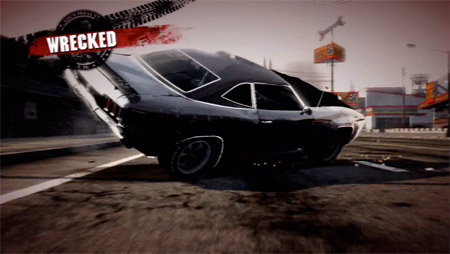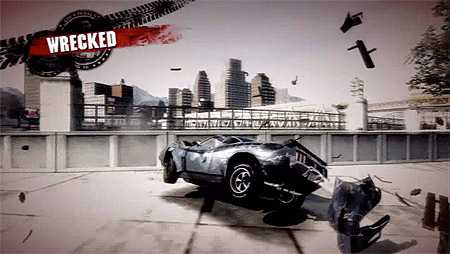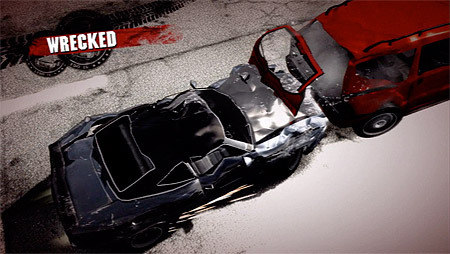While playing Electronic Art's recently released sandbox-racer demo of Burnout Paradise, I found myself absolutely jolted when I smashed my car, front-end first, into a wall. It wasn't the crash that startled me but my inability to do anything afterwards that had me flummoxed. Ever since I first tasted the glory of the Burnout series in Burnout 3, I had the ability to 'Aftertouch'. At the press of a button, I could initiate 'Impact Time' and enable the ability to slightly and slowly control the trajectory of my car, post-crash. Even though the camera angle was mostly locked, I could send my car veering towards a perceived rival car, or launch it into the air for a few laughs. It had become a convention of the series, appearing not only in the sequel Burnout Revenge, but also in the franchise-combo Burnout Dominator.
And now it was gone. Paradise's crashes greeted me with a vivid cut-scene of my car's hood and engine compacting against the stationary structure, metal crunching, sparks flying, painfully watching my car give way to the sudden release of energy. I could do nothing but sit and stare, although that didn't prevent me from fervently shifting the controller's sticks in the direction I wanted the car to careen towards.

Alas, my efforts were fruitless and, more often than not, fail to have the slightest impact on the camera. It felt like a step back for the franchise, as if an inalienable right had suddenly, and forcefully, been retracted. The Burnout series was previously quite progressive with how it allowed post-impact vehicular manipulation, and now I'm left with a lifeless car. My car no longer held a dying spirit fighting for that one last gasp, there was no pre-death-rattle convulsion. All that remained was a cut-scene.
While the full game harbors the spirit of Aftertouch in one of the ancillary modes, and while you can occasionally control the camera view during the tail-end of your crash, the fact that the primary game doesn't embrace it seems to stunt the series. What's especially strange about Aftertouch's removal is that it has been excised during a time when limited cut-scene interaction is at its peak! After all, the best moments of my 2007 gaming repertoire have involved similarly stunted interaction. BioShock, during the big reveal uses its restrained interactivity as a major plot point! And Half-Life 2: Episode Two closes with an arresting scene that restricts all player actions, except for your gaze, at a time when you're desperate for control. And even less successful first-person shooters like The Darkness act similarly, locking player movement to that of perspective during its introductory cut-scene (to a fault, I might add – I found myself frustrated with it's demo, jamming at my controller when introductory characters placed a gun in my hands and requested that I join their firefight, only to find that my character was inexplicably incapable of doing so).

While BioShock, Half-Life 2 and The Darkness are all monstrously narrative-driven creatures and Burnout is a spectacle-laden, score/position-driven game, it seems odd to dole out such an empowering device only to yank it away, especially when these newer cut-scenes can't be skipped. Burnout developers Criterion Games reason that they believed Aftertouch slowed the game down, but I feel quite the opposite. While the new cut-scenes are dynamically glorious, it was the interactivity of Impact Time that kept the pacing up, regardless of how slight it was. Aftertouch built up a fantastic amount of tension, tension that could only be teased out by restricting the player to a limited amount of input – not excising it all together.
Upon crashing, I'd find myself holding my breath, waiting see if my slight trajectory would takedown my rival, or miss them entirely, and I wouldn't exhale until my car found its resting place and the game brought me back into racing reality, ready to jump back into the action. The Burnout crash-scenes became a Hitchcockian thriller, teasing the viewer with a limited vantage point, refusing an optimal perspective for the unfolding events, forcing you to guesstimate where your car, and your rivals, would end up. It was pure exhilaration that nicely wound me down from velocity of the initial crash, but kept my heart pumped and primed to jump back into the race once Impact Time was over. The same simply cannot be said for a non-interactive cut-scene: Now I crash, I mournfully watch the carnage unfold and, once my car's restored, I sluggishly gas my way back down the road.

Yes, the absence of Aftertouch is lamentable, but the Burnout Paradise demo is still fantastic. The open-world structure works beautifully (so far), and I've pored more time into it than I have with several full-length Xbox 360 games. However, I can't help but twitch during these crash-scenes, balefully trying to direct my car towards more destruction, towards a more advantageous spawn point, towards fun. Each time quickly reminds me that this sandbox frowns on such interaction, and that I'll have to settle for landing wherever the game places me. I can deal with that, really. But, as engrossing and nicely composed as the crash-scenes are, I'll grow bored of them. Maybe not now, maybe not soon, but sometime in the future that boredom will turn to resentment, and that resentment will be taken out on the eject button. We'll see how many hours I expend on the game before that expunging takes place.
These impressions were garnered from the Xbox 360 demo.




#1 Fiddytree Dec 23, 2007 04:43am
I haven't played the demo yet but I'll be sure to check it out tomorrow. I used to love burnout back in the day and it's sad to see the aftertouch not included in the demo since I remember that being my favorite part. All the car wrecks and aftertouch set burnout apart from some of those other racing games.